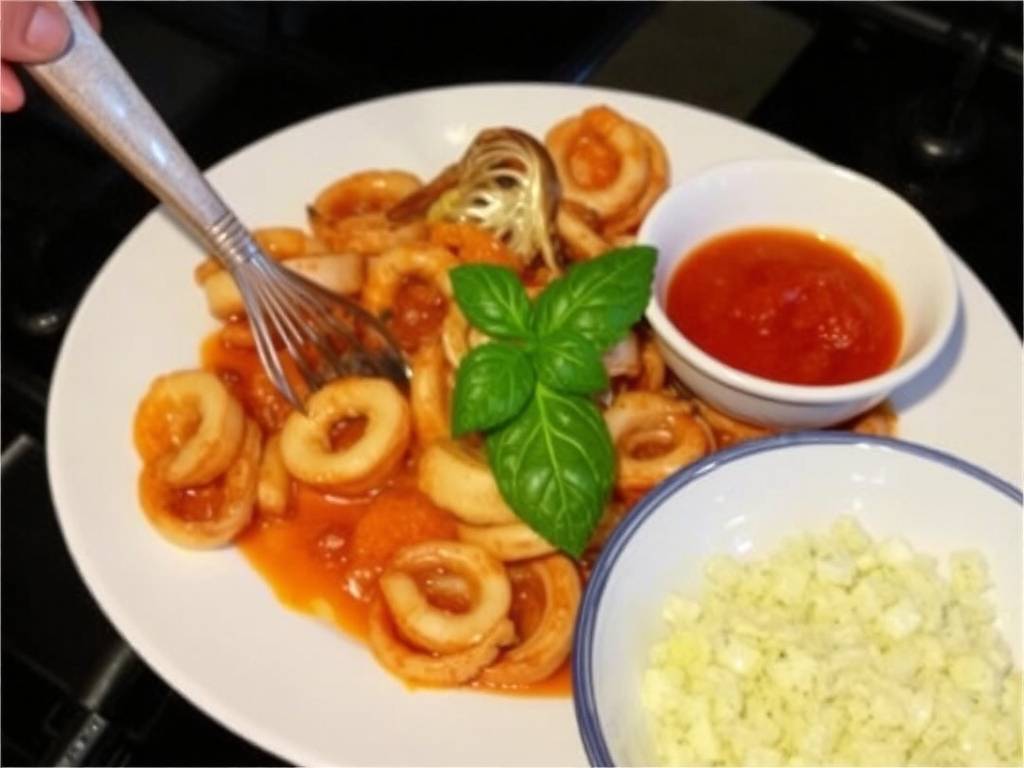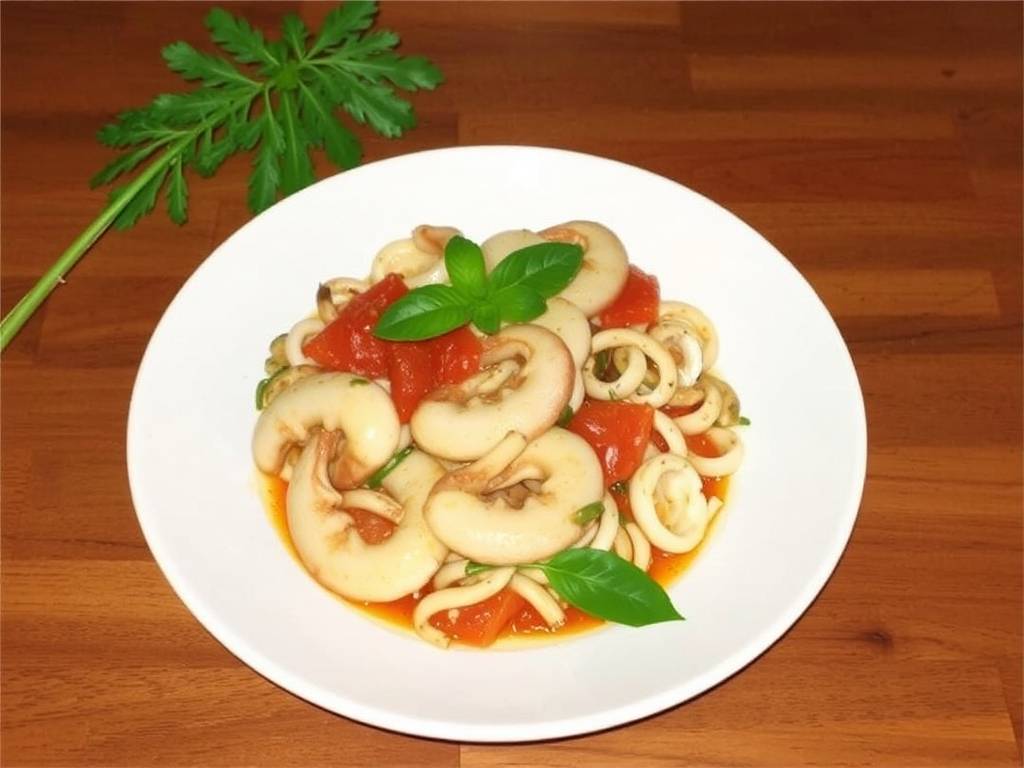A Culinary Journey: Mastering Squid with Garlic and Tomato Sauce
The ocean offers a bounty of treasures, but few are as versatile, delicate, and quick to prepare as squid. When paired with the robust, earthy tones of garlic and the bright, sweet acidity of fresh tomatoes, it transforms into a dish that sings of the Mediterranean. "Calamari all'aglio e pomodoro" is more than a recipe; it's a celebration of simple, high-quality ingredients coming together in perfect harmony. This guide will not only walk you through the technical steps but also delve into the science and art behind creating an exceptional Squid with Garlic and Tomato Sauce, a dish perfect for a sophisticated weeknight dinner or an impressive gathering with friends.
The Foundation: Selecting and Preparing Your Squid

The journey to a perfect dish begins at the market. Freshness is paramount. Look for squid with firm, glossy flesh that smells clean and briny, like the sea, with no hint of ammonia. The eyes should be clear, and the skin should be a pearly, translucent grey with speckles of mauve and pink. You can often find whole squid or pre-cleaned tubes and tentacles. While pre-cleaned is convenient, understanding how to clean a whole squid empowers you to ensure every part is pristine.

To clean a whole squid, gently pull the head and tentacles away from the body. The innards will come out attached. Cut the tentacles from the head just below the eyes, ensuring the tentacle cluster remains intact. Discard the head and innards. Remove the quill, a clear, plastic-like piece of cartilage, from inside the body tube. Rinse the tube thoroughly under cold running water, peeling away the thin, spotted outer membrane. Pat everything completely dry with paper towels. This step is crucial, as excess moisture will prevent a good sear.
Now, for the cut. While rings are common, for a stew-like dish such as this, cutting the squid tubes into larger, irregular pieces or leaving smaller squid whole allows them to hold their shape better during cooking and provides a more satisfying texture.
The Holy Trinity of Flavor: Garlic, Tomatoes, and Olive Oil
This dish relies on a trinity of ingredients, each playing a critical role.
-
Garlic: Do not reach for the pre-minced jar. Use fresh, firm garlic cloves. The preparation matters. Thinly slicing the garlic, rather than mincing it, allows it to infuse the oil with a more profound, sweeter flavor without burning as quickly. We will gently toast it to a pale gold, unlocking its nutty potential, which forms the aromatic base of our sauce.
-
Tomatoes: The soul of the sauce. While high-quality canned San Marzano tomatoes are an excellent year-round option, this recipe truly shines with fresh, ripe, in-season tomatoes. Roma or plum tomatoes are ideal due to their firm flesh and lower water content. The key technique here is peeling and deseeding. Score a small 'X' on the bottom of each tomato and blanch them in boiling water for 30-60 seconds, until the skin starts to peel back. Immediately transfer them to an ice bath. The skins will slip off effortlessly. Cut them in half, scoop out the seeds with a spoon, and then dice the flesh. This process, called concassé, removes the tough skin and watery seeds, leaving you with pure, concentrated tomato flavor that will break down into a luxurious sauce, not a watery soup.
-
Olive Oil: Use a good quality extra-virgin olive oil. Its fruity, peppery notes are integral to the dish's character. It’s not just a cooking medium; it’s a core ingredient.
The Cooking Process: A Dance of Heat and Timing
The most common mistake when cooking squid is treating it like a piece of chicken or beef. Squid requires either a very brief, high-heat cook or a long, slow braise. Anything in between results in a tough, rubbery texture. For this recipe, we employ a hybrid method: a quick sear followed by a relatively short simmer in the tomato sauce.
Step 1: Searing the Squid Heat a tablespoon of olive oil in a large skillet or sauté pan over medium-high heat until it shimmers. Pat your squid pieces dry once more—this is non-negotiable for a proper sear. Add the squid in a single layer, being careful not to overcrowd the pan (work in batches if necessary). Sear for just 45-60 seconds per side, until the pieces curl up and develop a light golden-brown color. The goal is not to cook them through but to develop a flavorful crust. Remove the squid from the pan and set it aside. It will finish cooking in the sauce.
Step 2: Building the Aromatic Base Reduce the heat to medium-low. Add another two tablespoons of olive oil to the same pan. Add your thinly sliced garlic and a generous pinch of red pepper flakes. The gentle heat will slowly toast the garlic, releasing its aroma without letting it turn bitter. This should take about 1-2 minutes. You should smell a wonderful, nutty fragrance. The moment the garlic turns a pale gold, it's time for the next step.
Step 3: Creating the Tomato Sauce Increase the heat to medium. Add your prepared diced tomatoes, a large pinch of salt, and some freshly ground black pepper. Stir well, scraping up any browned bits (the "fond") left by the squid from the bottom of the pan. These bits are packed with flavor. Let the tomatoes cook down for 8-10 minutes, stirring occasionally, until they have broken down and thickened into a rustic, chunky sauce. For a smoother sauce, you can use a potato masher to break them down further.
Step 4: The Harmonious Union Now, return the seared squid and any accumulated juices to the pan. Stir gently to coat every piece in the vibrant red sauce. Add a splash of dry white wine (optional, but highly recommended for acidity and depth) and let it simmer for another 2-3 minutes. The squid will finish cooking in this time, becoming perfectly tender. Overcooking now will make it tough again. Taste and adjust the seasoning with more salt, pepper, or a pinch of sugar if the tomatoes are particularly acidic.
Step 5: The Finishing Touches Just before serving, stir in a handful of fresh, chopped parsley. Its bright, grassy flavor cuts through the richness beautifully. A final drizzle of your best extra-virgin olive oil over the top just before serving adds a glossy sheen and a burst of fresh fruitiness.
Serving and Pairing Suggestions
This dish is incredibly versatile. Serve it over a bed of al dente linguine or spaghetti to soak up every drop of the glorious sauce. It is equally magnificent with crusty, grilled bread for a lighter meal or as an appetizer. For a gluten-free option, serve it over creamy polenta or alongside roasted potatoes.
A crisp, acidic white wine is the perfect companion. A Sauvignon Blanc, a Vermentino, or a Pinot Grigio will complement the garlic and tomato notes without overpowering the delicate squid.
Conclusion: Embracing the Art
Cooking Squid with Garlic and Tomato Sauce is a lesson in respecting your ingredients. It teaches the importance of proper preparation, the science of heat control, and the magic that happens when a few simple elements are treated with care. From the careful cleaning of the squid to the gentle toasting of the garlic and the transformation of fresh tomatoes into a luscious sauce, every step is an intentional act of creation. So venture into your kitchen, embrace the process, and prepare to be transported to a sun-drenched Italian coastline with a single, sublime bite.






发表评论